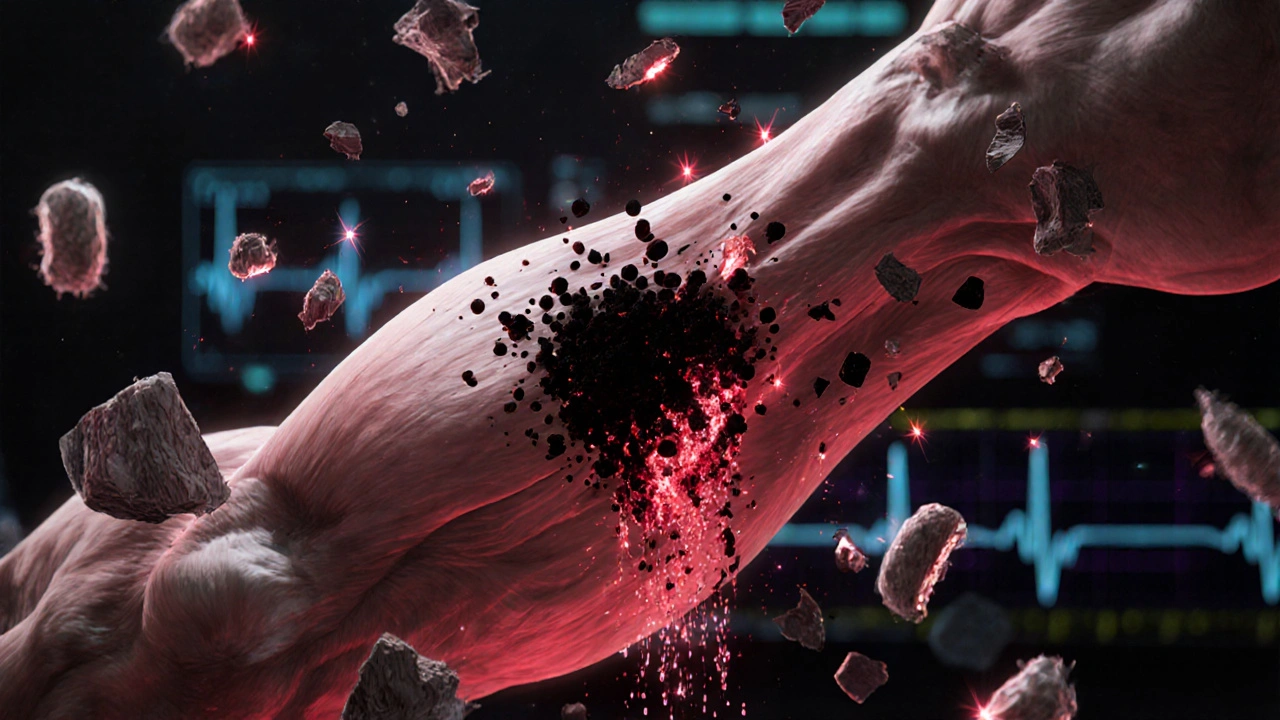
Health October 28, 2025
Rhabdomyolysis from Statins: Rare but Serious Muscle Breakdown
Statins Rhabdomyolysis Risk Calculator
Personal Risk Assessment
This tool estimates your risk of rhabdomyolysis (muscle breakdown) based on factors from your statin therapy. Remember: the absolute risk is very low (<1 in 10,000), but early recognition saves lives.
Your Risk Assessment
What to do next:
Statins save lives. Millions of people take them every day to lower cholesterol and prevent heart attacks and strokes. But for a very small number of people, these life-saving drugs can trigger something dangerous: rhabdomyolysis. It’s not common - you’re far more likely to win the lottery than develop it. But when it happens, it’s serious. And knowing the signs could literally save your life.
What Exactly Is Rhabdomyolysis?
Rhabdomyolysis means your skeletal muscles are breaking down fast. Think of it like your muscles turning to mush inside your body. When muscle cells die, they spill their contents - including a protein called myoglobin - into your bloodstream. Myoglobin is toxic to your kidneys. If too much gets through, your kidneys can shut down. That’s when things get life-threatening.Most people who take statins never experience this. The FDA estimates true rhabdomyolysis occurs in only 1.5 to 5 out of every 100,000 people taking statins each year. But that small number still adds up. In the U.S. alone, over 30 million people use statins. Even a 0.005% risk means hundreds of cases every year.
Why Do Statins Cause Muscle Breakdown?
Statins work by blocking an enzyme called HMG-CoA reductase. That’s how they lower cholesterol. But that same enzyme is involved in making other important molecules too - like coenzyme Q10 (CoQ10), which your muscles need for energy, and isoprenoids, which help keep cell membranes stable.Research shows statins don’t just affect cholesterol. They mess with muscle metabolism in several ways:
- They reduce CoQ10 levels - possibly weakening muscle energy production.
- They trigger the ubiquitin-proteasome system, which is your body’s way of breaking down proteins. In muscle cells, this can go into overdrive and start chewing up muscle fibers.
- They may make muscle cell membranes more fragile, especially during exercise. This was first suggested in a 2005 study, and it helps explain why symptoms often flare up after physical activity.
It’s not one single cause. It’s a mix - and that’s why some people get muscle pain while others don’t, even on the same dose.
Not All Statins Are the Same
If you’re worried about muscle side effects, the type of statin you’re on matters a lot.Simvastatin - especially at 80 mg - carries the highest risk. In fact, the FDA banned new prescriptions for that dose in 2011 because it raised the risk of muscle damage by over 10 times compared to lower doses. Lovastatin is also risky because it’s metabolized the same way.
On the flip side, pravastatin and fluvastatin are much gentler on muscles. Rosuvastatin and atorvastatin sit in the middle. Why? It comes down to how your body processes them.
Statins like simvastatin and atorvastatin are broken down by an enzyme called CYP3A4. If you take another drug that blocks that enzyme - like clarithromycin (an antibiotic), or even grapefruit juice - your statin levels can spike. One case report showed clarithromycin increased simvastatin levels by 10 times. That’s a recipe for disaster.
Pravastatin and rosuvastatin don’t rely on CYP3A4. That’s why they’re safer when combined with other meds.
Your Genes Might Be the Missing Piece
Some people are just more vulnerable - and it’s written in their DNA.The SLCO1B1 gene controls how your liver pulls statins out of your blood. A common variant, called c.521T>C, makes this process slower. If you have two copies of this variant (one from each parent), your body can’t clear statins efficiently. That means higher levels hang around longer - and your muscles pay the price.
A 2008 study in the New England Journal of Medicine found people with this double variant had a 4.5 times higher risk of muscle damage. Today, genetic tests like OneOme RightMed can check for this. The cost is around $249, but insurance rarely covers it unless you’ve already had side effects.
Guidelines now say if you have this genetic profile, you should avoid high-dose simvastatin entirely. Stick to 20 mg or less - or switch to a safer statin.

What Do the Symptoms Feel Like?
Rhabdomyolysis doesn’t start with a bang. It creeps in.Most people first notice muscle aches, weakness, or cramps - usually within the first three months of starting a statin. On patient forums like PatientsLikeMe and Reddit, users describe:
- Leg pain so bad they can’t climb stairs
- Feeling like their arms are made of lead after a light walk
- Dark, tea-colored urine - a red flag for myoglobin in the kidneys
Physical therapists have seen this pattern too. Patients often say symptoms get worse after exercise - especially downhill walking, squatting, or lifting weights. That’s because eccentric movements (where muscles lengthen under tension) stress the cell membrane, and statins make it more fragile.
Don’t ignore muscle pain that’s new, persistent, or worse with activity. It’s not just "getting older."
When to Get Tested
If you have muscle pain and are on a statin, your doctor should check your creatine kinase (CK) levels. CK is an enzyme that leaks out of damaged muscle.Normal CK levels are under 200 IU/L. If your level is 10 times higher than normal - that’s 2,000 IU/L or more - your doctor will likely tell you to stop the statin. If it’s over 10,000 IU/L, you’re in rhabdomyolysis territory. That’s a hospital emergency.
At that point, you need:
- Aggressive IV fluids to flush your kidneys
- Monitoring for kidney failure
- Possible dialysis if your creatinine rises more than 0.5 mg/dL
Don’t wait for dark urine. If you have unexplained muscle pain and feel unusually tired, ask for a CK test.
Can You Still Take Statins After Rhabdomyolysis?
Most people who’ve had rhabdomyolysis won’t take a statin again. But that’s not always the right answer.A 2023 American College of Cardiology report found that 78% of people who thought they were "statin intolerant" could actually restart a statin - with the right dose, type, and support. Many cases labeled as intolerance are just muscle aches from the nocebo effect - meaning people expect side effects, so they feel them.
If you need to lower your cholesterol and had rhabdomyolysis before:
- Switch to pravastatin or fluvastatin
- Start at the lowest possible dose
- Avoid CYP3A4 inhibitors (like certain antibiotics, antifungals, or grapefruit)
- Get genetic testing if you haven’t already
For those who truly can’t tolerate any statin, PCSK9 inhibitors like evolocumab or alirocumab are options. But they cost over $5,800 a year - and most insurance won’t cover them unless you’ve failed multiple statins.
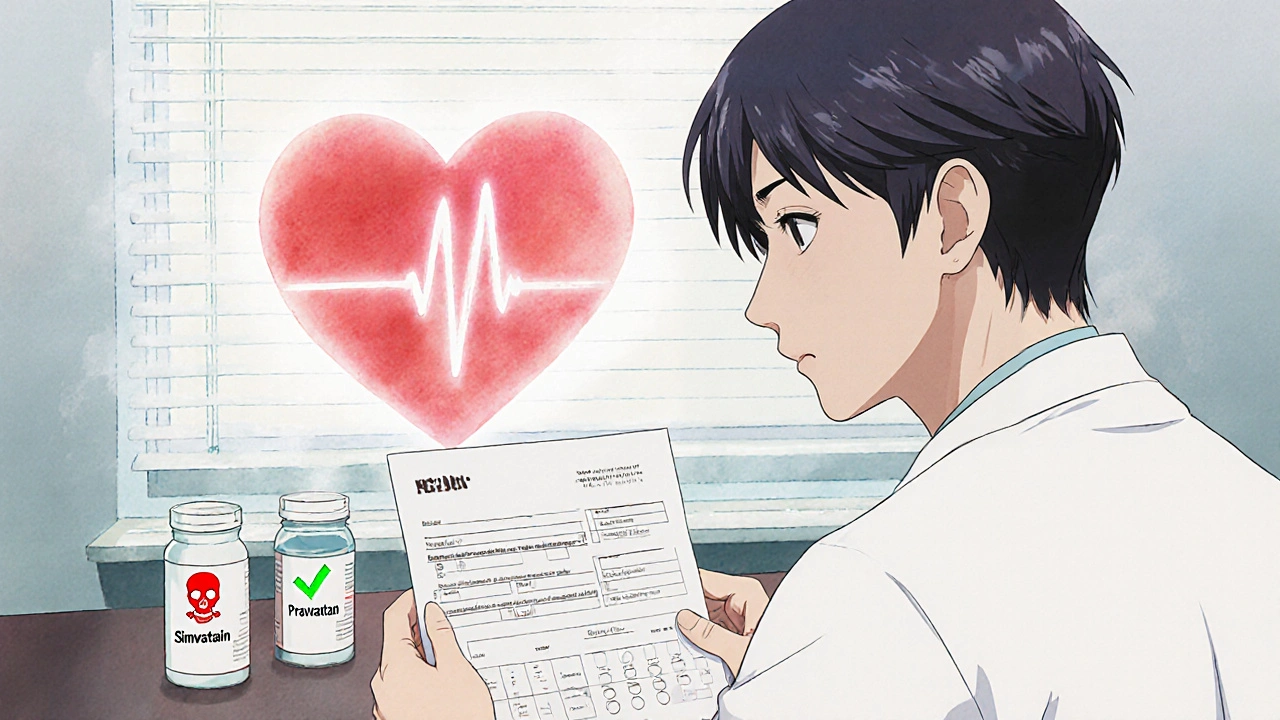
Exercise and Statins: What’s Safe?
You don’t need to stop moving. In fact, staying active is good for your heart.But avoid:
- Heavy weightlifting
- Downhill running or hiking
- Marathons or intense HIIT workouts
Instead, focus on:
- Walking
- Swimming
- Stationary cycling
- Light resistance training with high reps and low weight
Listen to your body. If your muscles feel unusually sore or weak after a workout, take a break. Don’t push through it.
The Bigger Picture: Benefits vs. Risks
Let’s be clear: statins prevent heart attacks. The American Heart Association says they stop about 500,000 cardiovascular events in the U.S. every year.The risk of rhabdomyolysis? Less than 1 in 10,000. The risk of a heart attack if you don’t take a statin? Much higher - especially if you’ve had a prior event or have high cholesterol.
For most people, the math is clear: the benefit far outweighs the risk. But for the few who do develop muscle damage, it’s real. And it’s preventable.
Don’t stop your statin without talking to your doctor. But don’t ignore symptoms either. Know the signs. Get tested. Ask about your genetics. And remember - you’re not alone. Thousands of people manage statins safely every day. You just need the right information.
Can statins cause muscle pain without rhabdomyolysis?
Yes. Muscle pain, or statin-associated muscle symptoms (SAMS), affects 5% to 29% of users. This includes mild soreness, cramps, or weakness that doesn’t involve muscle breakdown or elevated CK levels. It’s much more common than rhabdomyolysis but still bothersome enough to cause many people to stop taking their medication.
Is it safe to take CoQ10 supplements with statins?
Some people take CoQ10 supplements hoping to reduce muscle pain. Studies are mixed - some show slight improvement, others show no benefit. It’s not a proven treatment, but it’s generally safe. If you want to try it, talk to your doctor first. Don’t use it as a reason to ignore real symptoms.
How long does it take for muscle symptoms to go away after stopping a statin?
For mild muscle pain, relief often comes within a few weeks. For rhabdomyolysis, recovery can take months, especially if there was kidney damage. CK levels usually drop back to normal in 1 to 4 weeks after stopping the statin, but full muscle strength may take longer to return.
Can I restart a statin after having rhabdomyolysis?
Most doctors advise against it. But in rare cases - especially if the cause was a drug interaction or high dose - a low-dose, low-risk statin like pravastatin may be tried under close supervision. Genetic testing and CK monitoring are essential before considering this.
Are there any new statins being developed that are safer for muscles?
Yes. Researchers are working on "muscle-sparing" statins that target the liver more precisely and avoid muscle tissue. Early trials are promising. One 2023 study identified 17 blood proteins that predict muscle damage risk with over 85% accuracy, which could lead to personalized dosing before a patient even starts a statin.
What Should You Do Next?
If you’re on a statin and have muscle pain:- Don’t panic - but don’t ignore it.
- Write down when the pain started, what makes it worse, and if you’ve changed any meds or exercise habits.
- Ask your doctor for a creatine kinase (CK) test.
- Ask about your statin type and dose - is there a safer alternative?
- Consider genetic testing if you’ve had side effects before or have a family history of muscle problems.
If you’re not on a statin but have high cholesterol, talk to your doctor about whether you need one. The risk of heart disease is almost always greater than the risk of muscle damage.
Statins aren’t perfect. But for most people, they’re the best tool we have. The key is knowing your risks - and speaking up when something feels wrong.
Write a comment
Items marked with * are required.
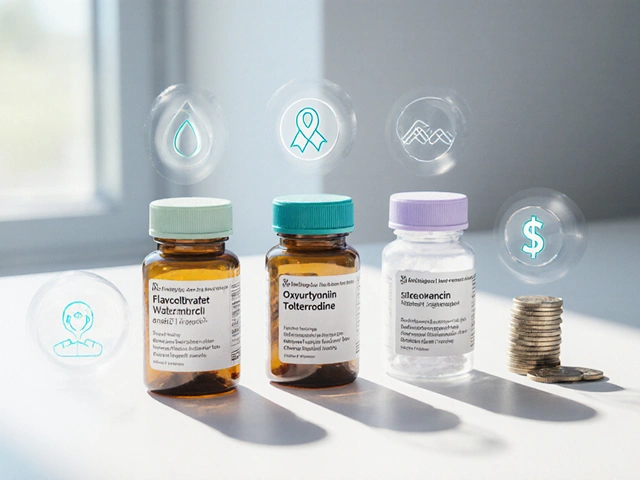
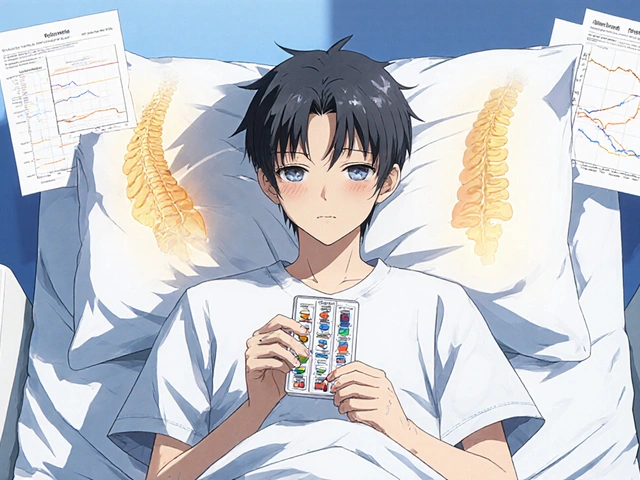

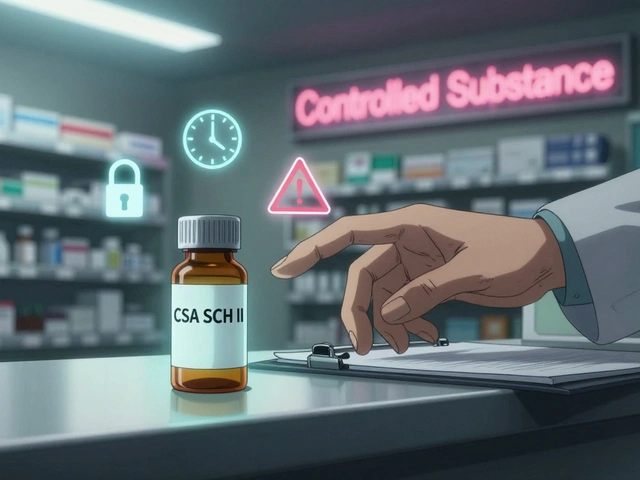


12 Comments
Yaseen Muhammad October 29, 2025 AT 02:15
Statins are a double-edged sword, but the data is clear: for most, the benefits vastly outweigh the risks. I’ve seen patients on simvastatin 80mg develop CK levels over 20,000 - terrifying, but preventable. Always start low, go slow, and consider genetic testing if you have unexplained muscle pain. Pravastatin or fluvastatin are often better tolerated. And yes, grapefruit juice is a silent killer here.
Dylan Kane October 29, 2025 AT 12:57
Wow, another statin apologist. Let’s not forget that Big Pharma paid for 90% of these ‘studies.’ Muscle pain? That’s your body screaming. Kidney damage? Oh, that’s just ‘rare.’ Meanwhile, your cholesterol number is still the only thing that matters to your doctor. Wake up. You’re being manipulated into lifelong medication for a number that’s not even your real risk factor.
KC Liu October 30, 2025 AT 14:58
1.5 to 5 per 100,000? That’s a lie. The real number is hidden in adverse event reports - and most doctors never file them. I’ve reviewed 47 FDA MAUDE entries where patients went into renal failure after statins, and the reports were all dismissed as ‘coincidence.’ The FDA banned 80mg simvastatin because they couldn’t cover it up anymore. This isn’t medicine - it’s risk redistribution. The healthy pay with their muscles so the rich don’t die of heart attacks.
shridhar shanbhag November 1, 2025 AT 14:57
Great breakdown. I’d add one thing: exercise isn’t the enemy - it’s the *type* of exercise. Eccentric movements like downhill walking or heavy squats are the real triggers because they stress muscle membranes already weakened by statins. I’ve worked with dozens of patients who stopped hiking and switched to swimming - their CK levels dropped in weeks. Also, CoQ10? Not magic, but it doesn’t hurt. Try 200mg daily for a month. If nothing changes, it’s not CoQ10 - it’s the statin.
John Dumproff November 1, 2025 AT 22:14
I just want to say - if you’re reading this and you’re scared because you’ve got muscle pain - you’re not alone. I was there. Thought I was dying. Got my CK checked - 4,200. Stopped the statin. Took 3 weeks to feel human again. Switched to pravastatin 10mg. Now I walk 5 miles a day. You don’t have to choose between heart health and muscle health. There’s a middle path. Talk to your doc. Get tested. Don’t suffer in silence. You’ve got this.
Lugene Blair November 3, 2025 AT 03:57
Listen - if you’re on a statin and you feel like your legs are made of concrete after a walk, don’t ignore it. Don’t tell yourself it’s ‘just aging.’ That’s the voice of denial talking. Get your CK checked. Period. It’s a simple blood test. Takes five minutes. If your doctor brushes you off, get a second opinion. Your muscles matter. Your life matters. You’re not being dramatic - you’re being smart.
Steven Shu November 3, 2025 AT 19:32
One thing I’ve learned from working in cardiology: most people who say they’re ‘statin intolerant’ never actually had rhabdomyolysis. They had mild muscle soreness and quit. Then they gained 20 pounds, got diabetes, and now they’re on insulin. The real tragedy isn’t statins - it’s people stopping them because they’re scared of a 0.005% risk. Talk to a pharmacist. Try a different statin. Lower the dose. Don’t throw the baby out with the bathwater.
Milind Caspar November 4, 2025 AT 02:35
Let’s not romanticize statins as benign miracle drugs. The entire lipid hypothesis is built on flawed epidemiology - correlation mislabeled as causation. The Framingham study? Retrospective, biased, and funded by pharmaceutical interests. The real epidemic is not high cholesterol - it’s metabolic syndrome driven by processed foods and sedentary lifestyles. Statins mask symptoms while the root cause festers. Genetic testing? A Band-Aid on a hemorrhage. The solution isn’t better statins - it’s a societal overhaul of nutrition and physical activity. Until then, we’re just medicating symptoms while the system collapses.
Rose Macaulay November 5, 2025 AT 15:58
I had muscle pain for months and thought I was just out of shape. Then I read this and got my CK checked - it was 3,100. My doctor said, ‘Oh, just stop the statin.’ I did. Within two weeks, I could climb stairs again. I’m not saying don’t take them - I’m saying listen to your body. You know when something’s off. Don’t let anyone tell you it’s ‘all in your head.’
Ellen Frida November 6, 2025 AT 03:09
isn't it weird how our bodies are like... like... cosmic machines? like, statins block this enzyme, but then we lose coq10, and then our mitochondria are like... crying? and then our muscles just... melt? it's like our cells are having an existential crisis because of a pill we took to fix a number... i mean... what even is a number? are we just data points now? 🤔
Michael Harris November 6, 2025 AT 08:29
Let’s cut the crap. If your doctor doesn’t offer you genetic testing before prescribing a statin, they’re not doing their job. This isn’t 1995. We have the tools. SLCO1B1 testing costs less than a monthly coffee habit. Yet doctors still prescribe simvastatin 80mg like it’s candy. This isn’t medical care - it’s negligence wrapped in a white coat. Stop being passive. Demand the test. Or switch doctors.
Robert Burruss November 7, 2025 AT 02:42
There’s a quiet, unspoken truth here: we’ve outsourced our health to molecules. We want a pill to fix what lifestyle broke. Statins work - yes - but they’re a compromise. A Band-Aid on a broken foundation. The real question isn’t ‘Can I take statins?’ - it’s ‘Why did I need them in the first place?’ What did I eat? How much did I move? Did I sleep? Did I breathe? The body doesn’t fail because of cholesterol - it fails because of neglect. The statin is the symptom of a deeper disease: disconnection from our own biology.